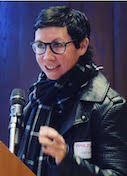From Curiosity to Cure
Marc Kvansakul
La Trobe University, Australia
Published December 13, 2011
Marc Kvansakul decided to become a structural biologist as a young teen after watching a documentary that described proteins as assemblies of Lego-like blocks. Today Kvansakul’s newly formed lab in the department of biochemistry at La Trobe University in Victoria, Australia, is using what he has learned about the sequences and structures of anti-apoptotic viral proteins to start developing new treatments for Burkitt lymphoma, a form of the disease known to be caused by the Epstein-Barr virus.
Not exactly the same as building yellow and red plastic-brick scale models, but, says Kvansakul, “it’s all very good fun.”
Kvansakul began this line of research during post-doctoral work under structural biologist Peter Colman at the Walter & Eliza Hall Institute in Melbourne. First they studied M11L, a Myxoma pox virus protein that helps viruses survive by disabling an infected host cell’s self-destruction program. Kvansakul and Colman wanted to understand how.
The challenge was particularly interesting because M11L, amino acid sequence-wise, looks unlike anything else. But Kvansakul found that, crystal structure-wise, M11L looks a lot like a known mammalian anti-apoptotic protein called Bcl-2. “We uncovered a completely new area in sequence space that forms the same fold,” says Kvansakul, who used SHARP and PHASER to solve the structure, Coot to build the model and CNS to refine it. He published the findings in 2007 in Molecular Cell.
Now, he says, “we’re going fishing” for other viral proteins that, sequence-wise, look a little like M11L to see if they also turn out to be anti-apoptotic. So far, in his own lab at La Trobe, he has found a few hits suggesting there may be a conserved sequence pattern that builds this important fold. “The fact that we found a molecule that forms the same fold but is only 3% identical on a sequence level tells us that there surely must be loads of these proteins in lots of viruses,” says Kvansakul. Only they can’t be found with a computational search. “Once we work out the biology, we can think about how we can build a search algorithm to find other proteins,” he says.
After that 2007 study, Kvansakul and Colman completed a study of BHRF1, a viral protein in Epstein-Barr virus that blocks apoptosis. Kvansakul found that the viral protein blocks multiple pro-apoptotic proteins in host cells, and that in a mouse model of Burkitt lymphoma it also renders chemotherapy agents ineffective, making it a potent oncogene. The results, also obtained using SHELX, PHASER, Coot and REFMAC, appear in 2010 in PLoS Pathology.
Now in his lab at La Trobe, Kvansakul is working with a medicinal chemist to identify small molecules that block BHRF1’s anti-apoptotic function. “Out of me just being interested in structures has turned into, ‘Oh, why don’t we develop new treatments for Burkitt lymphoma?” he says.
While setting up his lab in 2010 and worrying about how he would manage he lab’s computing needs, Kvansakul happened upon mention of SBGrid online. “I thought, this is sent by Heaven!” he says.
Being in Australia, Kvansakul didn’t make it to SBGrid’s June 2011 Symposium personally. Instead, he invited his lab over for a late dinner and then, around 11pm, they all settled into his lounge and watched the live web feed until 7am. “During prime party hours the students were happy to listen to the speakers and take notes,” he says. “It was brilliant.”
As a graduate student and post-doc, Kvansakul used O—“praising and cursing Alwyn Jones in equal amounts”—and CNS and a few other tools. “The more I work, the more tools I learn about,” and happier he is that that he has SBGrid to manage it all.
As an example, at a conference this summer, he heard about a new technique recently implemented in CNS called deformable elastic network refinement (DEN). “I got home and a couple of weeks later, there was an upgrade from SBGrid and we could run it,” he said. “This is exactly why I signed up with these guys. There are probably lots of things out there I haven’t heard of yet, and hopefully I’ll start running into them too.”
-- Elizabeth Dougherty


























































































